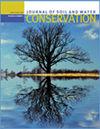干旱区经济和气候因素对农业用水的影响
IF 2.6
4区 农林科学
Q2 ECOLOGY
引用次数: 0
摘要
在整个干旱的美国西部,农业是主要的用水消耗,农业生产依赖于有限的地下水资源或有限的地表水来进行必要的灌溉。本研究利用气候、经济和遥感土地覆盖数据,对影响亚利桑那州中部农民用水决策的因素进行建模。种植者的用水需求通过地下水、科罗拉多河通过亚利桑那中部项目输送的水和额外的地表水来满足。所提出的建模方法适用于广泛的依赖灌溉的农业社区。本研究特别考察了亚利桑那州中部灌区的输水量和灌溉强度。综合面板数据的计量经济学分析发现,气候、12月棉花期货价格、水成本和休耕土地面积对两个结果中的至少一个有显著影响。了解灌溉者的用水决定对那些关注水资源供应对当地经济、生态系统和含水层影响的人是有用的。本文章由计算机程序翻译,如有差异,请以英文原文为准。
Effects of economic and climatic factors on agricultural water use in arid regions
Throughout the arid American West, agriculture is the dominant consumptive use of water, with farming operations dependent on finite groundwater resources or limited surface flows for necessary irrigation. This study makes use of climatic, economic, and remote-sensed land cover data to model those factors that contribute to farmers’ water use decisions in central Arizona. Growers’ water needs are met through a combination of groundwater, Colorado River water delivered via the Central Arizona Project, and additional surface flows. The modeling approach presented is applicable to a wide range of agricultural communities that are dependent on irrigation for agriculture. This study specifically examines water deliveries to and irrigation intensity within irrigation districts in central Arizona. Econometric analysis of integrated panel data finds that climate, the prices of December cotton (Gossypium hirsutum L.) futures, water costs, and fallowed land area have significant impacts on at least one of the two outcomes of interest. Understanding irrigators’ water use decisions is useful to those concerned with the impact of water availability on local economies, ecosystems, and aquifers.
求助全文
通过发布文献求助,成功后即可免费获取论文全文。
去求助
来源期刊
CiteScore
4.10
自引率
2.60%
发文量
0
审稿时长
3.3 months
期刊介绍:
The Journal of Soil and Water Conservation (JSWC) is a multidisciplinary journal of natural resource conservation research, practice, policy, and perspectives. The journal has two sections: the A Section containing various departments and features, and the Research Section containing peer-reviewed research papers.

 求助内容:
求助内容: 应助结果提醒方式:
应助结果提醒方式:


